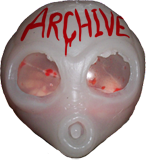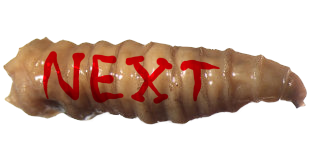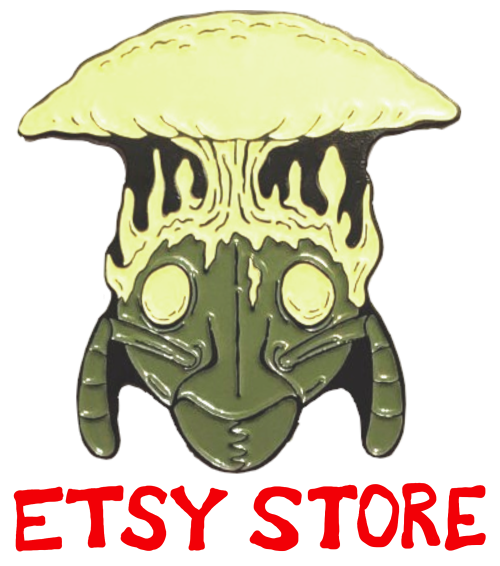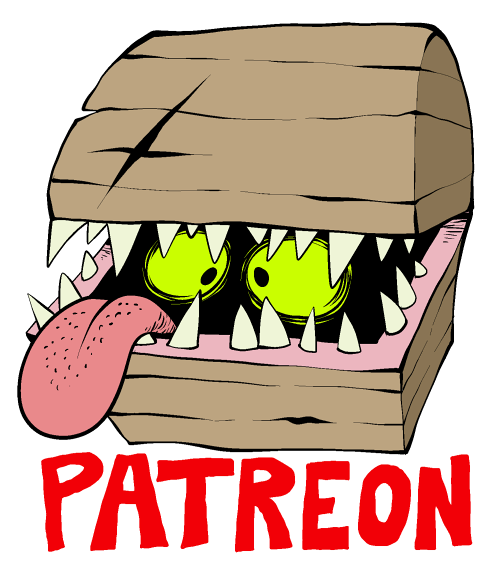Written by Jonathan Wojcik
Pieter Breugel's Rebel Angels!
An entire lifetime ago for Halloween 2012, I reviewed some of my favorite demons from the paintings of Hieronymus Bosch, but there was another painter I thought I would cover as part of the same series. Unfortunately, I had difficulty finding higher-resolution images of Pieter Bruegel's work at the time, and returning to the subject would just sort of slip my mind for an entire seven years.
So, it may seem out of the blue, but I'm pretty excited to now be able discuss the creature designs of a guy who died over four hundred years ago. Bruegel was, in fact, born less than a decade after Bosch's death, and is seen by many as his spiritual successor. The reason will be pretty obvious as we take a look at the weirdos populating one of his most famous creations, The Fall of the Rebel Angels!

Click to Enlarge!
The full piece was completed in 1562, and is thought to have been painted by request of an art collector who may themselves have been a fan of Bosch and recognized the similarity in Bruegel's style. The scene depicts precisely what the title suggests: the moment when an army of rebellious angels, lead by the devil himself, were driven out of heaven and fell to Earth. The idea that the fallen took on strange, inhuman forms along the way is obviously a very, very old one, and the forms conceived here by Bruegel are not only wildly creative but astoundingly unsettling. Take a few moments to pore over the high-resolution photo if you want, and then we're diving right in with no particular order!

The Falling Angels
There sure are a lot of those, aren't there? Practically an avalanche of Zion's recently unemployed tumble from the sky, and their features have already begun to warp. Why does that happen? The most superficial answer is that everybody thought "evil" beings would probably look scary and weird, but I think a clearer reason has always kinda stared us in the face: literal interpretation of the bible holds that both humans and angels were created special in the physical likeness of God themselves. Once rejected by that same being, it makes sense that the "fallen" would no longer be capable of maintaining their creator's form, and so their bodies would have to borrow physical form from the rest of God's creation...but do they control these new forms, or is it more like a spontaneous "mutation?"

The Gaseous Anklebiter
I'm going to lean more towards "spontaneous mutation" here, or if the forms are at all "chosen" by the fallen, they can't choose them as well as they'd probably like, because a lot of them look pretty miserable to be what they are now. Perhaps it's simply a matter of them not even caring what they look like, because any form at all but their original one is obscene to them in some way.
So obscene, this one is starting to eat itself? The humanlike and reptile-like elements are combined in a genuinely unpleasant, unhealthy looking way, and even the beautiful moth-like wings feel strangely pitiful. The farting might be easy to make light of, but I imagine it's pretty horrific for an angel to suddenly experience the grossness of mortal physiology. It's just a fart, you big baby. We do it all the time. Get your leg out of your mouth.

Basically Just Geese
There are actually several angels in the painting who have transformed into waterfowl, which all look fairly normal except for this one. Actually, I guess I don't know if it's supposed to be a goose, since it is wingless, mostly featherless, and its head is a skull. It's gruesome enough without any context at all, but in the context of a previously "near-perfect" being cursed with a more degenerate form, it's pretty damn distressing.
 A Ghastly Goblin
A Ghastly Goblin
I guess I'm not sure if this one is just a head and arms or has some kind of long body. The incredibly long, red sack it wears could be either a gigantic hat or a tapering coat. You can really see how the demons of this era kept on inspiring fantasy artists such as Brian Froud well into the modern age - this guy would look perfectly at home in Labyrinth!

The Helmeted Goofball
Not every angel has lost every semblance of humanity, but the human features they have left are seldom dignified. If you ask me, the hilarious face of this figure only adds to its eeriness, not to mention the abnormally long, thin arms held entirely unlike those of a human. The rest of its body seems like it might be fish-like, but there isn't even all that much of it anyway. This one really is mostly head.

The Red-haired Harpy
A similar being is this howling, mace-wielding female angel, whose flesh is indistinguishable from her clothing and whose torso abruptly cuts off into...what? I don't even know how to describe this. Her breasts are obviously meant to evoke "eyes" above a bird-like "beak," but the whole structure is also formed out of fish-like fins. If there's any "objective" measure of creativity, it has to be the difficulty with which you can draw simple, clear comparison to anything else. That said, I was immediately inclined to think "Harpy" just because we've got aspects of a woman with sort of the aspects of a bird in there, just not in any way I've ever seen done elsewhere!

The Beast
The body of a huge, mammalian dragon can be seen at the center of the painting, and you can trace it to seven heads with seven golden crowns - that's the Beast of Revelations! Each head looks more comical than frightening by today's standards, and the one on the lower right is what most people would call adorable, but again, the context matters. It's interesting, when you look at artwork and writing this old, that people didn't really seem to have as strong a concept of animals being "cute." Animals just were. Perhaps it's just due to the average modern person's separation from nature and relative safety that we can't take fuzzy critters as seriously as people could centuries prior.

The Locusts
We've got another specific, named entity here too: these armored, long-tailed creatures with golden crowns and long, blonde hair are unmistakably the "Locusts of the Pit!" Among the many morbid and sadistic ideas put forth by Revelations, the "locusts" are supposed to be unleashed from hell by god himself during the end of days, in numbers so vast that every single unbeliever living anywhere on Earth will receive a single sting from their scorpion-like tails. The sting is said to cause five entire months of agony so great that people will attempt to kill themselves, only to find that death is impossible until the big angry sky guy says otherwise.
The description of the locusts having humanlike heads used to strike me as silly and uncool, but these faces are effectively hideous. They're hideous in a way that isn't even trying that hard to be hideous, but just off-human enough to look vile.
Shout out to that cool insect-winged boar creature back there, too.

The Bad Egg
Bosch used a lot of egg imagery in his demon pieces, so of course Bruegel follows suit. I like the tree branch and the saw sticking out, and the odd little "stinger" on the opposite end of the egg. I'm not seeing any wings, either, but I really hope this devil can still fly around. I want to see that. I want this stupid egg duck devil to just buzz around in the air like a little zeppelin. You laugh at the thought, maybe, but it wouldn't look as funny in person. Well, a little funny.

The Mystery
A lot of demonic figures in the painting are indistinct, but I feel like this one is especially ominous. I'm not sure if what I'm seeing is the side or underside of a dark, flapping, fish-moth-bat and I'm not sure if the round, black shape at the bottom is part of a humanlike head or something else, but it reminds me very much of the kinds of things we glimpsed only momentarily in the movie Jacob's Ladder.

The Sea Monster
A chimera with a cohesive theme! A giant crawdad-like form with a fishier tail and mussels for wings, organs and all, with a result that's once again much creepier than it has seemingly any right to be. Despite the easy access people had to all manner of seafood at the time, it wasn't often that you saw marine invertebrates painted in such accurate detail, either. We appear to be viewing the being's underbelly, but the face also gives the impression of the top of a cattle skull, without even really breaking from an anatomically believable crustacean.

The Big Bug
Speaking of invertebrates, insects are also shockingly rare in paintings of this era, or at least insects that actually look like insects. Bruegel goes the extra mil by inventing one entirely of his own, but the anatomy is still accurate enough that this creature could have hypothetically existed. A small, hairy body, a single pair of wings that indicate the order Diptera, and a swollen yellow abdomen on the end of a bizarre, thin stalk. There are insects exhibiting some of these features all over the world, but none to my knowledge that combine them together this way. This insect is accompanied by a swarm of tinier flies or wasps, but it feels unlikely that each one represents another fallen angel. Maybe they're this one's offspring?

The Pufferfish
A personal favorite, and one that I think a lot of people notice first when they take in the whole painting. This fat, round fish with the hair, eyes and teeth of some weird rat might be the simplest design of the whole bunch, something even a kid could draw fairly easily, but that's probably why it stands out so well, it's so easy to remember, and it feels like it has so much personality to it. It's certainly one of the cutest, but manages to give off some seriously menacing vibes nonetheless.

The Musical Crustacean
This is the GOOD stuff we're getting into. Look at that!!! It's got long, bony arms ending in lobster claws and a chitinous red pterosaur head, but the body is some kind of big, wooden string instrument! That is just daffy! How and for that matter WHY did a rebel angel literally just turn into this? Come to think of it, where did any of the inorganic elements come from on any of these creeps? They certainly don't look like weaponry or clothing they would have brought with them from heaven, especially if we're going by the non-fallen angels throughout the painting. I guess even their accessories had to transform into anything other than what Heaven provided them with.
Even more mysterious, perhaps, is where that regular looking fish came from, unless it was another particularly unlucky angel.

The Egg Sack
I actually saw this corner of this painting recycled into a book cover when I was a small child, and this particular figure haunted me for days. It still wants to. It combines the aesthetics of a plucked chicken with the pallid, bloated body of a drowned frog, its beady eyes and toothless mouth seemingly begging for death as it unbuttons its stomach cavity to display a torso full of cracked bird's eggs.
W-H-Y???? I know there's no answer and there's not supposed to be an answer, but this is by far the worst form any of these beings has to have been cursed with. Think of it through the lens of the biblical lore involved here, if you weren't already: this used to be an angel. One moment it was one of the purest, mightiest, most beautiful beings in all the universe, bathing in rapturous ecstacy for all eternity under the light of its omnipotent and ostensibly loving creator...and the next moment, it's whatever the shit this is, entirely because a higher ranking angel convinced it and thousands of others that they could wrench heaven away from the big shiny guy and seize control of their own destiny.
I say this as someone who acknowledges this all as pure fantasy, but I feel like just the sight of this miserable thing gives me a brand new appreciation for what the fallen angels actually went through; that this is something experiencing a level of humiliation and loss a human can never possibly fathom. After that, can you really even fault them for anything they do?

The Protective Parent?
There's quite a bit going on with this figure. Its head is a combination of bird and fish, which can also be said of the little "babies" it so lovingly carried in a basket, though it's difficult to tell if those things are even actually alive at all. They kind of have a dried corpse look to them, don't they?
Regardless, this former angel seems so desperate to save the little things that it kicks at an archangel with a frail, emaciated leg inexplicably ending in a pomegranate instead of a foot. I'm sure there must have been some symbolism intended here, but all I see is a heartbreakingly pitiful figure, and that likely wasn't an accident on Bruegel's part; artists of the period including Bosch himself slipped a lot of social satire into their paintings of Heaven and Hell, satire completely lost on a humorless church establishment.
By our standards today, it's almost unbelievable to imagine someone looking at this painting and not feeling pure sympathy for a suffering, panic-stricken zoological menagerie at the mercy of a few coldly emotionless, blandly conformist archangels, but there really were people - and probably still are people - who see this image and think "yes. Good. Those ugly things went against my god's rules and absolutely deserve this."
It's not a thought that really fits with modern sensibilities. I certainly don't want to think of a sobbing baby frog man as a villain who deserves to burn forever. That's actually wildly uncomfortable to me. But...I think that also makes it kind of fascinating to me, too, and even genuinely frightening to imagine. Even without being the least bit spiritual, I see incredible horror potential in the idea of "fallen angels" as creatures simultaneously as pitiful and as wicked as can possibly be; that maybe even if they were just a bunch of sad, misunderstood victims at one time and now spend eternity as hurt, frightened little animals, there's consequentially a hate festering in them that we can't even imagine. That the sad puppy goblins really do just want to drag every single human into hell at this point and have completely, totally, absolute zero capacity to be reasoned with.
Maybe I got a little carried away by the end of this post, but somehow, I think I actually managed to find the classical angel/demon relationship cool again?!

Gaze upon the face of evil.
MORE HALLOWEEN FEATURES:







